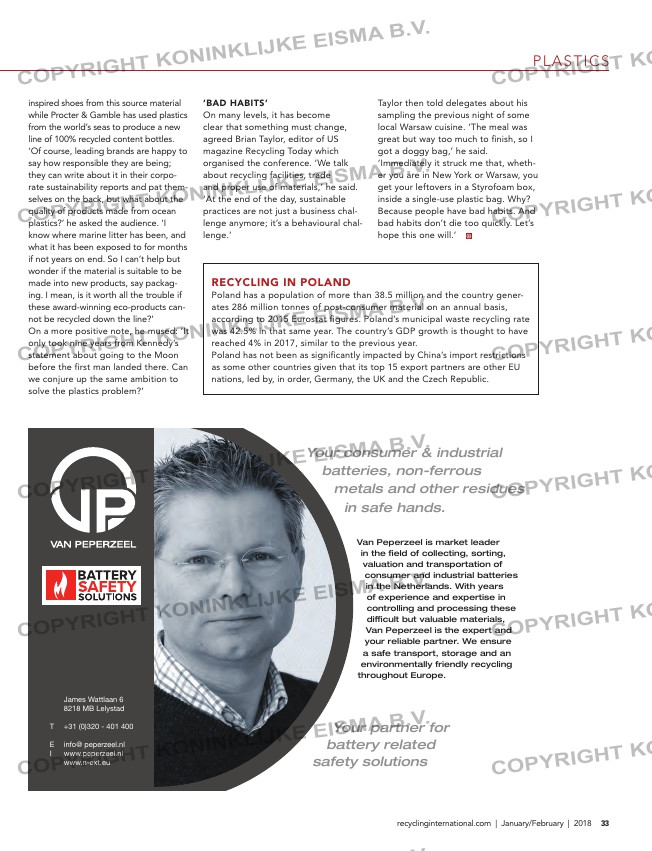Page 33 from: January / February 2018

plastics
33recyclinginternational.com | January/February | 2018
Van Peperzeel is market leader
in the field of collecting, sorting,
valuation and transportation of
consumer and industrial batteries
in the Netherlands. With years
of experience and expertise in
controlling and processing these
difficult but valuable materials,
Van Peperzeel is the expert and
your reliable partner. We ensure
a safe transport, storage and an
environmentally friendly recycling
throughout Europe. Not only for
batteries, but also for non-ferrous
metals and residues.
Your consumer & industrial
batteries, non-ferrous
metals and other residues
in safe hands.
Van Peperzeel
Your profit,
our expertise
James Wattlaan 6
8218 MB Lelystad
T +31 (0)320 – 401 400
F +31 (0)320 – 401 409
E [email protected]
I www.peperzeel.nl
Your partner for
battery related
safety solutions
E info@ peperzeel.nl
I www.
n-ext.eu
years’ time our industry will have
shrunk severely.’
Worth all the trouble?
Baxter also cited a recent UK survey
revealing that the public believes
approximately 50% of the world’s
plastic waste comes from Europe.
‘Let’s face it, the problem for which
we all get blamed has its roots in Asia
and Africa,’ he ventured. ‘Actually,
almost 85% of the plastic waste origi-
nates from 11 countries – and none of
them is in Europe.’ The list features
China, India, Vietnam, Indonesia, the
Philippines, Sri Lanka, Thailand, Egypt,
Malaysia, Nigeria and Bangladesh.
The most common microplastics are the
rubber particles coming off car tyres as a
result of motoring wear and tear,
remarked Edward Kosior of Nextek. He
also observed that transformation of
ocean plastics into useful products is
gaining traction: for example, sportswear
manufacturer Adidas has created eco-
inspired shoes from this source material
while Procter & Gamble has used plastics
from the world’s seas to produce a new
line of 100% recycled content bottles.
‘Of course, leading brands are happy to
say how responsible they are being;
they can write about it in their corpo-
rate sustainability reports and pat them-
selves on the back, but what about the
quality of products made from ocean
plastics?’ he asked the audience. ‘I
know where marine litter has been, and
what it has been exposed to for months
if not years on end. So I can’t help but
wonder if the material is suitable to be
made into new products, say packag-
ing. I mean, is it worth all the trouble if
these award-winning eco-products can-
not be recycled down the line?’
On a more positive note, he mused: ‘It
only took nine years from Kennedy’s
statement about going to the Moon
before the first man landed there. Can
we conjure up the same ambition to
solve the plastics problem?’
‘bad habIts’
On many levels, it has become
clear that something must change,
agreed Brian Taylor, editor of US
magazine Recycling Today which
organised the conference. ‘We talk
about recycling facilities, trade
and proper use of materials,’ he said.
‘At the end of the day, sustainable
practices are not just a business chal-
lenge anymore; it’s a behavioural chal-
lenge.’
Taylor then told delegates about his
sampling the previous night of some
local Warsaw cuisine. ‘The meal was
great but way too much to finish, so I
got a doggy bag,’ he said.
‘Immediately it struck me that, wheth-
er you are in New York or Warsaw, you
get your leftovers in a Styrofoam box,
inside a single-use plastic bag. Why?
Because people have bad habits. And
bad habits don’t die too quickly. Let’s
hope this one will.’
recyclIng In Poland
Poland has a population of more than 38.5 million and the country gener-
ates 286 million tonnes of post-consumer material on an annual basis,
according to 2015 Eurostat figures. Poland’s municipal waste recycling rate
was 42.5% in that same year. The country’s GDP growth is thought to have
reached 4% in 2017, similar to the previous year.
Poland has not been as significantly impacted by China’s import restrictions
as some other countries given that its top 15 export partners are other EU
nations, led by, in order, Germany, the UK and the Czech Republic.
30-31-32-33_conferencereport-plastics.indd 33 25-01-18 15:46



